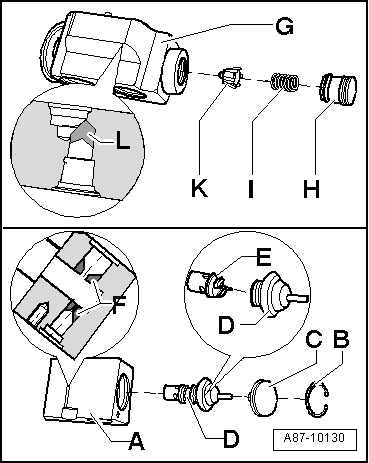| t
| After switching on, the rinsing cycle is first of all evacuated and while doing so the refrigerant circuit is tested for leaks (depending on the version of the A/C service station, manually moving forward is perhaps required see → operating instructions of the A/C service station). |
| t
| In the evacuated rinsing cycle, the corresponding specific volume of coolant (e.g. 4 kg) is filled in via the high-pressure side of the A/C service station (against the normal flow direction of the air conditioning and therefore on the low-pressure side of the refrigerant circuit of the vehicle). Depending on the version of the A/C service station, enough refrigerant is filled in until the rinsing cycle is completely filled with liquid refrigerant. This is determined in such a way that for a given period of time no more refrigerant can flow through. |
| t
| After topping up with the determined volume of refrigerant, for example, the heating of the flushing device for refrigerant circuits is switched on depending on the version of the A/C service station and the flushing device for refrigerant circuits (only if the refrigerant is drained off in gaseous condition from the flushing device for refrigerant circuits). |
| t
| After the refrigerant was drained off, the heating of the flushing device (if present) for the refrigerant circuits is switched off, the refrigerant circuit is again briefly evacuated depending on the version and after the evacuation, the refrigerant oil suctioned out of the refrigerant circuit is expelled out of the A/C service station. |
| t
| The procedure, fill with refrigerant, drain off (and evacuate) is repeated twice (altogether it is performed three times). |
After completing the purging processes:| –
| Check the inspection glass or the inspection glasses of the flushing device. If dirty, clean the purging process in accordance with the operating instructions of the flushing system and once again perform a check of the purging process (it lasts only one purging process, about 30 minutes). |
| –
| Remove the connections to the A/C service station from the refrigerant circuit of the vehicle (there must not be any overpressure present in the refrigerant circuit, if necessary briefly evacuate the refrigerant circuit once again). |
| –
| Replace throttle and catch pan/fluid reservoir with dessicator or only dessicator (specifically designed for vehicles). |
| –
| Vehicles with expansion valve - Check expansion valve, replace if dirty or corroded. |
| –
| Depending on the fault: |
| l
| Replace the AC compressor or unscrew the drain plug from the removed AC compressor (replace O-ring → Electronic Catalogue of Original Parts) and drain the remaining refrigerant oil. In order to speed up the evacuation of the refrigerant oil, turn the AC compressor with the clutch disk of the magnetic coupling by hand (disposal of used oil → Chapter). Subsequently fill the volume of new refrigerant oil, which corresponds to the refrigerant oil volume in the original part AC compressor, into the removed AC compressor → Heating, Air Conditioning → Rep. gr.87. |
|
 Note
Note
 Note
Note Note
Note Note
Note